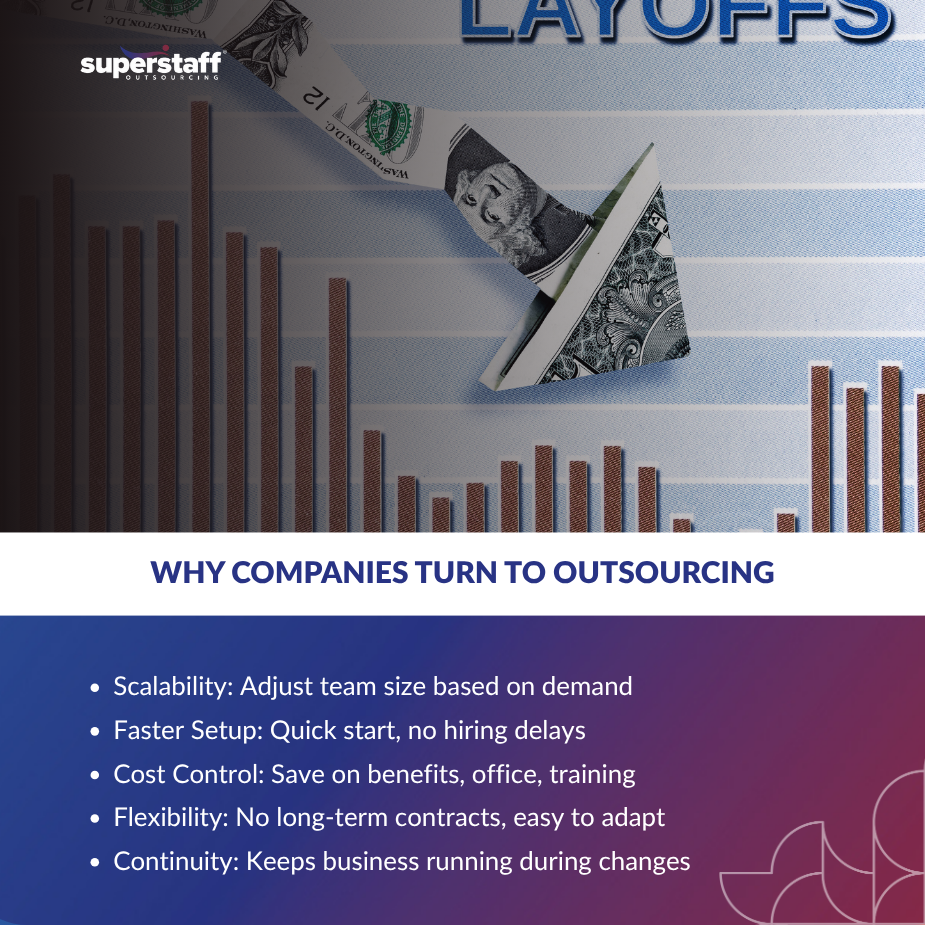
After a wave of company layoffs, leaders are left with a tough decision: how to keep operations going without immediately hiring full-time staff again. Some look to contractors. Others reduce the workload entirely. Many turn to outsourcing.
Outsourcing can help fill talent gaps, reduce costs, and bring in specialized support without long-term commitments. But it also raises questions about quality, company culture, and future growth.
As outsourcing trends 2025 continue to develop, companies need to look at both sides carefully. Is it a smart way to rebuild? Or does it bring new risks?
This article breaks down the business case for outsourcing after layoffs—what works, what doesn’t, and how to outsource effectively after company layoffs.
How Businesses Adjust After Mass Layoffs
Mass layoffs usually lead to three clear conditions in a business:
- Lower budgets
- Smaller teams
- More pressure on the remaining staff
Hiring freezes are common. The goal becomes maintaining output with fewer people and less money. Many companies also pause their hiring plans to avoid more disruptions.
These limits push leaders to look for flexible ways to support day-to-day operations without increasing fixed costs. That’s where outsourcing comes in. But it’s not a simple fix.
Why Companies Turn to Outsourcing

Outsourcing trends 2025 show that many businesses see outsourcing as a way to bounce back without overextending. The appeal comes from several benefits:
1. Scalability
Businesses can scale up or down depending on demand. This is useful for customer service, admin work, tech support, or back-office tasks.
2. Faster Setup
Outsourced staff can often start faster than full-time hiring, which avoids long delays in recruitment and training.
3. Cost Control
Outsourcing can cut expenses on:
- Employee benefits
- Office space and equipment
- Training and onboarding
4. Flexibility
Outsourcing doesn’t require long-term contracts. This gives businesses more room to test different options or change direction if needed.
5. Continuity
When done right, outsourcing keeps the business moving during a transition period—even when internal teams are short-staffed.
These reasons explain why outsourcing as a solution in post-layoff economy is becoming more common. But the approach also needs to be managed carefully to avoid setbacks.
Key Risks of Outsourcing After Layoffs
While the benefits are clear, outsourcing also brings risks, especially right after layoffs. Some of these include:
- Staff Morale – Remaining employees may feel uneasy when outsiders take over tasks they once handled.
- Quality Concerns – If outsourcing partners are poorly chosen or trained, service quality can drop.
- Loss of Internal Knowledge – Letting go of in-house roles too soon may mean losing skills or knowledge that are hard to replace.
- Overdependence – Relying too much on external vendors without checks and balances can reduce control over key areas.
All of these points lead to one lesson: outsourcing works best when there’s a clear plan. Without one, companies risk hurting long-term growth for short-term relief.
How to Outsource Effectively After Company Layoffs
To reduce risks and make the most of the benefits, companies must take a structured approach. Here’s a basic strategy for business process outsourcing that helps avoid common mistakes.
1. First, identify the right tasks to outsource
Focus on work that is repeatable, process-driven, and doesn’t require deep internal knowledge. These can include customer service, data entry, payroll processing, IT support, or lead generation. According to outsourcing trends 2025, businesses should avoid outsourcing strategic or highly specialized roles unless they have a strong vendor with proven experience and industry-specific expertise.
2. Next, choose the right vendor for the job
It’s important to partner with a service provider that understands your industry, offers flexibility in team size, has clear service-level agreements (SLAs), and provides consistent communication and support.
3. Then, set clear goals for the outsourcing engagement
Define success using specific metrics, such as response times, customer satisfaction scores, or error rates. Share these expectations with your team and the outsourcing provider to ensure alignment.
4. After that, communicate with your internal team about the outsourcing plan
Be open about which tasks will be handled externally, why the decision was made, and how this shift may or may not affect their roles. Transparency reduces uncertainty and helps maintain morale among the remaining staff.
5. Finally, monitor performance consistently
Set regular reviews, ask for reports, and track progress based on your original goals. Use these insights to make adjustments when needed and to build a stronger working relationship with your outsourcing partner.
By following this step-by-step approach, businesses can align their decisions with ongoing outsourcing trends 2025 and avoid the common pitfalls that come with rushed or unplanned outsourcing.
When Outsourcing Works Best in a Post-Layoff Economy
Outsourcing isn’t right for every situation. But there are some scenarios where it can make a real difference:
- Startups and small businesses rebuilding after layoffs with limited budgets
- Customer support departments dealing with volume changes or peak seasons
- Companies are testing new markets but are unsure about long-term investments
- Support functions like bookkeeping or tech help, where processes are already well-defined
In these situations, outsourcing allows companies to keep moving forward without committing to full-time hires too soon.
Outsourcing Trends 2025: What to Expect
As we move deeper into 2025, outsourcing continues to evolve. Key trends include:
- More demand for remote team support to reduce fixed costs
- Increased use of outsourcing for compliance, finance, and healthcare services
- A shift toward long-term partnerships instead of short, one-off contracts
- Stronger emphasis on vendor alignment with company values and goals
Companies that keep up with outsourcing trends in 2025 are more likely to make outsourcing a reliable part of their business strategy, not just a short-term fix.
A Balanced, Practical Approach
Outsourcing after layoffs can help companies control costs, improve flexibility, and support business continuity. But without planning, it may cause more harm than good.
The right strategy depends on clear goals, open communication, and strong vendor relationships. When handled well, outsourcing becomes a reliable part of a company’s long-term operations, not just a response to cuts.
Thinking of outsourcing after workforce changes? SuperStaff helps businesses build reliable, cost-effective support teams that align with company goals. If you’re considering outsourcing trends 2025 or looking for staffing alternatives, let us help you create a clear and practical path forward.






